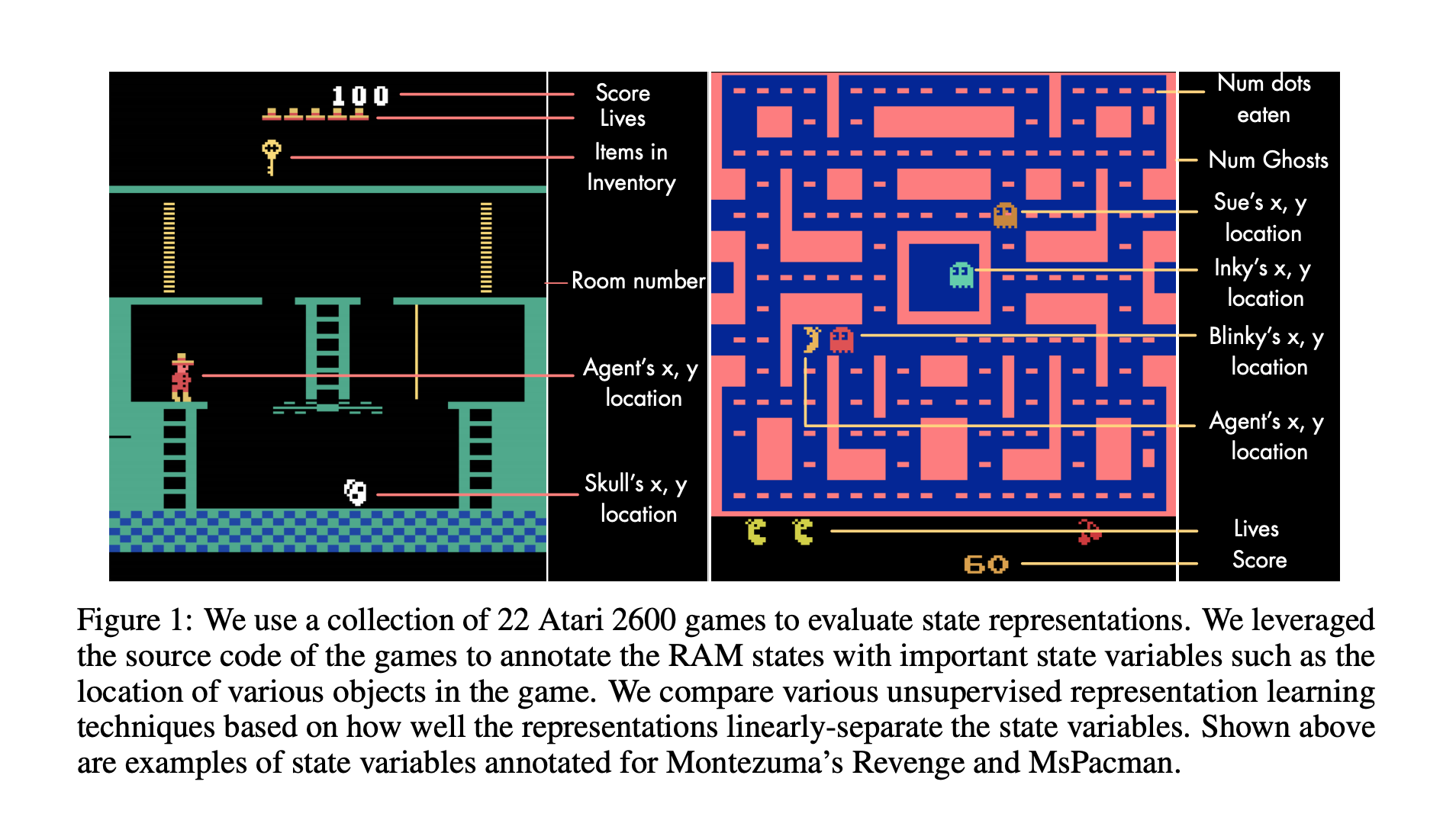Ankesh Anand*, Evan Racah*, Sherjil Ozair*, Yoshua Bengio, Marc-Alexandre Côté, R Devon Hjelm
https://arxiv.org/abs/1906.08226
State representation learning, or the ability to capture latent generative factors of an environment, is crucial for building intelligent agents that can perform a wide variety of tasks. Learning such representations without supervision from rewards is a challenging open problem. We introduce a method that learns state representations by maximizing mutual information across spatially and temporally distinct features of a neural encoder of the observations. We also introduce a new benchmark based on Atari 2600 games where we evaluate representations based on how well they capture the ground truth state variables. We believe this new framework for evaluating representation learning models will be crucial for future representation learning research. Finally, we compare our technique with other state-of-the-art generative and contrastive representation learning methods.
- PyTorch
- OpenAI Baselines (for vectorized environments and Atari wrappers)
- pytorch-a2c-ppo-acktr (for actor-critic algorithms)
- wandb (logging tool)
- gym[atari]
- opencv-python
To install the requirements, follow these steps:
# PyTorch
conda install pytorch torchvision -c pytorch
# Baselines for Atari preprocessing
git clone https://github.com/openai/baselines.git
cd baselines
pip install -e .
# pytorch-a2c-ppo-acktr for RL utils
git clone https://github.com/ankeshanand/pytorch-a2c-ppo-acktr-gail
cd pytorch-a2c-ppo-acktr-gail
pip install -e .
# Other requirements
pip install -r requirements.txtTo install the project:
git clone https://github.com/ankeshanand/atari-representation-learning.git
cd atari-representation-learning
pip install -e .AARI exposes the ground truth labels for different state variables for each observation. We have made AARI available as a Gym wrapper, to use it simply wrap an Atari gym env with AARIWrapper.
import gym
from aari.wrapper import AARIWrapper
env = AARIWrapper(gym.make('MontezumaRevengeNoFrameskip-v4'))
obs = env.reset()
obs, reward, done, info = env.step(1)Now, info is a dictionary of the form:
{'ale.lives': 6,
'labels': {
'room_number': 1,
'player_x': 77,
'player_y': 235,
'player_direction': 8,
'enemy_skull_x': 57,
'enemy_skull_y': 240,
'key_monster_x': 14,
'key_monster_y': 254,
'level': 0,
'num_lives': 5,
'items_in_inventory_count': 0,
'room_state': 8,
'score_0': 0,
'score_1': 0,
'score_2': 0}
}Note: In our experiments, we use additional preprocessing for Atari environments mainly following Minh et. al, 2014. See aari/envs.py for more info!
If you want the raw RAM annotations (which parts of ram correspond to each state variable), check out aari/ram_annotations.py
We provide an interface for the included probing tasks.
First, get episodes for train, val and, test:
from aari.episodes import get_episodes
tr_episodes, val_episodes,\
tr_labels, val_labels,\
test_episodes, test_labels = get_episodes(env_name="PitfallNoFrameskip-v4",
steps=50000,
collect_mode="random_agent")Then probe them using ProbeTrainer and your encoder (my_encoder):
from aari.probe import ProbeTrainer
probe_trainer = ProbeTrainer(my_encoder, representation_len=my_encoder.feature_size)
probe_trainer.train(tr_episodes, val_episodes,
tr_labels, val_labels,)
final_accuracies, final_f1_scores = probe_trainer.test(test_episodes, test_labels)To see how we use ProbeTrainer, check out scripts/run_probe.py
Here is an example of my_encoder:
# get your encoder
import torch.nn as nn
import torch
class MyEncoder(nn.Module):
def __init__(self, input_channels, feature_size):
super().__init__()
self.feature_size = feature_size
self.input_channels = input_channels
self.final_conv_size = 64 * 9 * 6
self.cnn = nn.Sequential(
nn.Conv2d(input_channels, 32, 8, stride=4),
nn.ReLU(),
nn.Conv2d(32, 64, 4, stride=2),
nn.ReLU(),
nn.Conv2d(64, 128, 4, stride=2),
nn.ReLU(),
nn.Conv2d(128, 64, 3, stride=1),
nn.ReLU()
)
self.fc = nn.Linear(self.final_conv_size, self.feature_size)
def forward(self, inputs):
x = self.cnn(inputs)
x = x.view(x.size(0), -1)
return self.fc(x)
my_encoder = MyEncoder(input_channels=1,feature_size=256)
# load in weights
my_encoder.load_state_dict(torch.load(open("path/to/my/weights.pt", "rb")))src/ contains implementations of several representation learning methods, along with ST-DIM. Here's a sample usage:
python -m scripts.run_probe --method infonce-stdim --env-name {env_name}